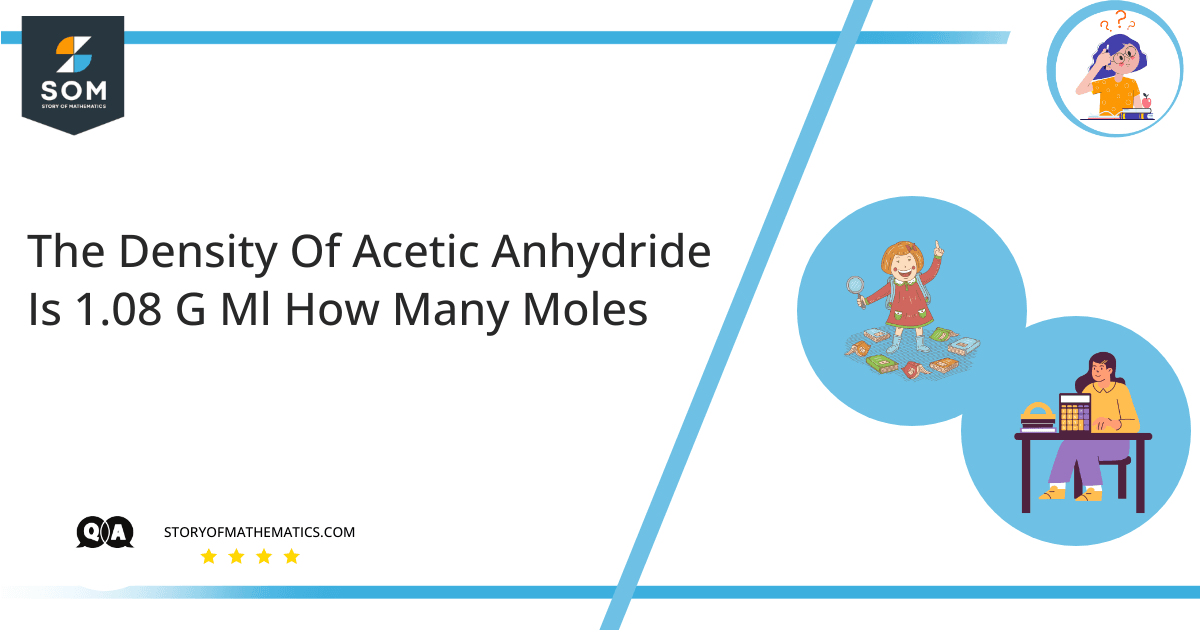
The aim of this question is to learn the calculations involved in molar proportions of chemical compounds.
This is a three-step process. First, we find the molar mass of the given compound using its chemical formula. Second, we find the no. of moles contained in unit volume using the following formula:
\[ 1 \ mL \ of \ chemical \ compound \ = \ y \ mole \]
Third, we find the no. of moles contained in the given volume using the following formula:
\[ x \ mL \ of \ chemical \ compound \ = \ x \ \times \ y \ mole \]
Expert Answer
The chemical formula of acetic anhydride is:
\[ C_4 H_6 O_3 \]
Since:
\[ \text{Molar mass of carbon } = \ 12 \ amu \]
\[ \text{Molar mass of hydrogen } = \ 1 \ amu \]
\[ \text{Molar mass of oxygen } = \ 16 \ amu \]
So:
\[ \text{Molar mass of acetic anhydride } = \ 4 \ ( \ 12 \ ) \ + \ 6 \ ( \ 1 \ ) \ + \ 3 \ ( \ 16 \ ) \ amu \]
\[ \Rightarrow \text{Molar mass of acetic anhidride } = \ 48 \ + \ 6 \ + \ 48 \ amu \]
\[ \Rightarrow \text{Molar mass of acetic anhydride } = \ 102 \ amu \]
This means that:
\[ 1 \ mole \ of \ acetic \ anhydride \ = \ 102 \ g \]
Alternatively:
\[ 102 \ g \ of \ acetic \ anhydride \ = \ 1 \ mole \]
\[ \boldsymbol{ \Rightarrow 1 \ g \ of \ acetic \ anhydride \ = \ \dfrac{ 1 }{ 102 } \ mole } \ … \ … \ … \ (1) \]
Given:
\[ \text{ Density of acetic anhydride } = \ 1.08 \ \frac{ g }{ mL } \]
Which means:
\[ 1 \ mL \ of \ acetic \ anhydride \ = \ 1.08 \ g \]
Using the value of $ 1 \ g $ from the equation (1):
\[ 1 \ mL \ of \ acetic \ anhydride \ = \ \times \ 1.08 \ \times \ \dfrac{ 1 }{ 102 } \ mole \]
\[ \Rightarrow 1 \ mL \ of \ acetic \ anhydride \ = \ \dfrac{ 1.08 }{ 102 } \ mole \]
\[ \boldsymbol{ \Rightarrow 1 \ mL \ of \ acetic \ anhydride \ = \ 0.010588 \ mole } \ … \ … \ … \ (2) \]
For $ 5 \ mL $ quantity, equation (2) becomes:
\[ 5 \ mL \ of \ acetic \ anhydride \ = \ 5 \ \times \ 0.010588 \ mole \]
\[ \boldsymbol{ \Rightarrow 5 \ mL \ of \ acetic \ anhydride \ = \ 0.053 \ mole } \]
Numerical Result
\[ 5 \ mL \ of \ acetic \ anhydride \ = \ 0.05294 \ mole \]
Example
For the same chemical compound, Calculate the no. of moles contained in $ 1 \ L $.
Recall equation (2):
\[ 1 \ mL \ of \ acetic \ anhydride \ = \ 0.010588 \ mole \]
For $ 1 \ L \ = \ 1000 \ mL $:
\[ 1000 \ mL \ of \ acetic \ anhydride \ = \ 1000 \ \times \ 0.010588 \ mole \ = \ 10.588 \ mole \]
